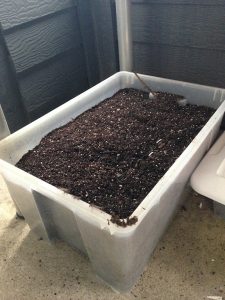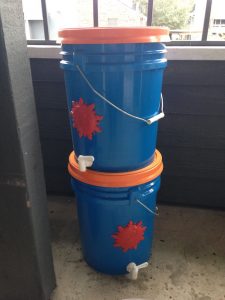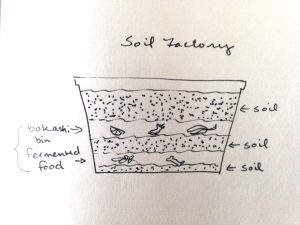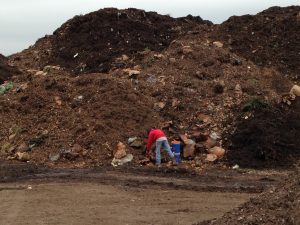The end of this saga is that we compost our food scraps. But how we got there is an eight months’ story of failure, flies, stink and slop. In fact some of the flies are still with us today, but I think their days are numbered.
It began last year, a few months into my zero waste project. I realised that a lot of our trash was actually food scraps, about the 40% that seems to be the average figure. This means that 40% of what we were throwing away was actually useful organic material, which would naturally break down and return nutrients to the soil if allowed to do so, instead of sitting and producing greenhouse gasses in a landfill.
Now, we don’t have access to city compost collection. The only collection options would be private collectors, paid for by us. Nor do we have any garden space to keep our own compost heap, which would really be the easiest method. So being cheap, and having a balcony and an old broken flowerpot, I decided to see what I could achieve by throwing scraps into it. There’s nothing I love so much as a ridiculous project undertaken with inadequate materials and likely doomed to failure.
Attempting a homemade compost pot
In my compost flower pot, I was careful only to include fruit and vegetables, no meat or dairy, which require more heat to decompose than a home heap can provide. I added leaves as they fell onto our balcony, and kept the pot covered with a cloth secured with a rubber band, to keep animals out. I stirred it around every few days and added a little water to keep it just damp.
You know, I claim it was working. It did not stink like trash. It just smelled loamy. It blackened with time. A few flies hung around, but not a hoard.
One day, I found the cover off, but never figured out how. I supposed I had left it off by accident. But then a few days later, stirring my compost around, I smelled a bad smell. I thought I saw something of an unsavoury, stinky nature. I’ll never be sure, but I think it was evidence that a cat pooped in my compost. A CAT! The nerve! In case you don’t know, cat poop is not compostable because it can carry diseases, and you should especially not use the contaminated compost for growing food. So I trashed it.
I stopped awhile to reconsider my plans. I began again, this time with a plastic bin which I punched holes in for drainage. It had a lid, which I also punctured for aeration, and could secure to prevent pests. Take that, cats. It so happened that we had a week of rainy days immediately after this, so the bin – out on our balcony – filled with water beyond its capacity to drain, and by the time the weather dried and I peeked at my compost, it was soggy, smelly and crawling with maggots.
Oh, I am nothing if not tenacious, so I did try to salvage it. I poured kettlefuls of boiling water over it to kill the maggots (their carcasses littered the balcony for a while after), but it was never the same, and always prone to infestation. Finally, while I was doing the KonMari method, I decided that box of failed compost didn’t give me joy. I hated it. So I lugged the whole thing to the dumpster, not even trying to salvage the box to recycle or reuse. I needed a clean break.
A bokashi bin
Battle-weary, I withdrew to the fortifications of my laptop and researched further options. I decided that the best choice for us was something called a bokashi bin.
This is an enclosed system, meaning it is airtight and thus impervious to pests and not smelly – so ideal for a balcony. Moreover, although a bokashi system is a more expensive method of composting, our city offers rebates for part of the cost of a home composting system, defraying some of the costs for us. Not only that, but a bokashi bin can handle any type of food, including meat and dairy products.
So we splurged and got ourselves a bokashi bin system: two 5-gallon buckets which stack.
Perfect, right?
The main downside to a bokashi bin is actually a symptom of its greatest strength. The reason it can accept all food waste is that, rather than actually composting, a bokashi bin uses a kind of starter culture to ferment food scraps. Fermentation breaks down the food’s nutrients while also killing any dangerous bacteria, hence why it can digest meat. However, when your bokashi bin is full and finished fermenting, you do not have usable compost. In fact what you have, technically, is pickled food. To finish breaking down into actual compost, it should ideally be buried in a garden, where oxygen and microbes can finish it off, or else simply added to a conventional compost heap.
I knew this, and had a plan. As our first bin filled up, I struck up an agreement with some family members to dump its contents into their composter. Great! System in place. I am so eco-friendly!
The time of stink and flies
There came an autumn evening when my sister came over for dinner. We were hanging out, and I was about to empty the scraps from the day’s cooking into the bokashi bin. But the bin was full. No problem, time to move it to the bottom of the stack and bring the empty bin to the top.
Except that ’empty’ second bin was actually full. Oops. I had lost track of my plan and failed to empty it before it was needed again.
Okay, still no problem. I had a plan. I was going to make a soil factory: this is a way to make usable compost out of bokashi bin ferment, using a big storage container full of soil instead of an actual garden. You are supposed to layer the fermented food scraps with soil, and pile more soil on top, lasagna-style, in a big plastic storage bin, and let it sit for a while until it has darkened and broken down. After that, you should have a lovely planting medium for a container garden.
So, on the dark balcony, I grabbed my storage bin and dumped my five gallons of fermented scraps into it. It slopped out as a pile of acrid-smelling, bleached-looking but rather recognisable food. And a lot of pungent liquid. Here was another mistake: you are supposed to drain the liquid through the spigot on the bucket, because otherwise the fermented food is too wet to compost well. The liquid is elegantly called compost tea. But I had forgotten to drain it, either while it was fermenting or just before dumping it out, so SLOSH! out came the liquid.
I now had a big plastic storage container, stinking to high heaven of blanched old food swimming in greasy, putrid liquid.
Since I had a dinner guest at this time, I left it alone to deal with later.
Deal with it, I tried. I stirred in potting soil, using my tiny garden spade to heft around the mountain of pickled food in the bin. I dug down a ‘well’ at one corner and scooped out the pooling liquid with a cup. I tried to tip the heavy bin sideways to drain it without emptying it all over the balcony. I kept adding shredded paper and cardboard, and dry leaves, to soak up the moisture. I hoped the hot weather would steam it out.
Eventually, though, I paid for my mistake. Insects smelled the moist, ripe heap and made it their home. Big flies, small gnats, clouds of them. They wormed their way through the seals on our balcony door and partied in our kitchen and our bathroom. They died by the dozens in the vinegar traps we set for them, the survivors cavorting around the edges of the bowl where their mates had drowned.
I ended up calling the manufacturer of our bokashi bins to ask for advice. My mistake, I learned, aside from having too much liquid in my fermented matter, was in failing to cover the top of my soil factory bin with sufficiently thick soil. Because my fermented food was damp, and sitting on the surface or barely concealed with soil, it was just inviting flies. If it had been topped with several inches of dry soil, it would have smelled less and been too arid to tempt them.
Meanwhile, the flies moved into my potted plants, where, I learned, the larvae would feast on my seedlings and kill them. I eventually opened chemical warfare on them, dousing the soil with diluted hydrogen peroxide and buying a bacterial insecticide, upon advice from several organic gardening websites and my local garden center.
Perhaps, an actual solution
Remember, though, the flies have sidetracked us from the original goal, which was to compost food scraps to avoid sending them to landfill.
What dawned on me, during the autumn and winter as I was digging in a vat of gross stuff and killing flies, was that no matter what small-scale solutions I found for using my bokashi bin fermented food, ultimately we would produce much more of it than I could use. I was still recovering from the trauma of emptying the last bucket when both buckets were full again, and there was no way I could build soil factory after soil factory, every six weeks when a bucket needed emptying. I had no way of using that much compost. Meanwhile, my brother-in-law informed me that his composter (which ate my first bokashi bucket’s contents) was full.
And indeed, unless you grow a large amount of your own food in something like a homestead, even with a proper garden I don’t think you could use all the compost your food waste produced. A normal household just produces more food waste than a typical urban garden can use.
Over Christmas, I put a plastic bag inside our kitchen compost collection bucket, and when it was full, threw out the first batch of food scraps I had actually trashed since July, when we got the bokashi bins. But both our bokashi bins were stuffed full, and I didn’t know how to empty them.
The solution for us would have to involve getting rid of either our scraps, or the fermented contents of our bokashi bin, somewhere that could handle a greater volume. I ended up using a great website, Compost Coalition, which coordinates many of the independent composting facilities in our city. Through this site, I found a commercial facility that agreed to let me empty my buckets on their site for a small nominal fee.
Mercifully, they even manhandled the buckets and emptied them for me, so I was spared the nasty task. They added our paltry contribution to a pile of compost two stories high. Oh, they also took our Christmas tree and the branches from my homemade wreath.
For now, this will be our solution. It requires about a 25-minute drive and a small fee, but since we fill two buckets only every three months or so, it could be sustainable for now. I like knowing it’s possible, anyway. Meanwhile, I’ll keep my eye out for something more local and less trouble, and being better informed now, probably try my chances at the soil factory again, and use the occasional bokashi bucket’s output to enrich my container garden.

You may be asking, as indeed I have asked at times, Why, why, why? Why am I doing this to myself just to avoid throwing away potato peels?
Well, first of all, once we started the bokashi bins and I got all that food out of our trash, we went 5 weeks without emptying it. There was simply not much there, and nothing that smelled. The lid of the trash can didn’t get dirty. Liquid didn’t seep down and stink at the bottom of the bin. I didn’t have to dread opening it because of the smell after only a week. I really enjoyed that – a gross area of my house was suddenly quite clean, and a gross weekly task was nearly eliminated.
Furthermore, once I started collecting our food scraps to compost, I realised their volume and felt even more strongly that I didn’t want to throw them away. Food scraps represent nutrients, and as I understand it, one problem of modern agriculture is that the soil is depleted; our food itself is less nutritious because the soil is impoverished. That’s partly because all those nutrients are being sent to landfill when they should be sent back to the soil. I can only say that, once I saw a glimmer of possibility that I could send all that nutrition somewhere useful, instead of somewhere that caused a problem, I really, really wanted it to work.
Finally, I’ll admit there’s some stubbornness here, because I was testing an idea and wanted to prove it would work. At a few points, I realised that our situation is precisely the one that makes composting extremely difficult: no city collection, no nearby dumping site, no access to a garden or ground soil, and no large planting space to accept the finished compost. And a warm fly-ridden climate. Yet part of my goal with attempting this zero waste project has been to see how it fits with an urban, apartment-dwelling, single-income family lifestyle. I think it can. But only time will tell, I suppose, exactly how far we could go, or how sustainable it is in the long term.
As I said, though, right now, we compost!



One thought on “Zero Waste: The Composting Saga”